17.4 Configuring a SwyxLink Trunk
When you have created a SwyxLink trunk as described in 17.3 Creating a SwyxLink Trunk, you can subsequently change the settings of this trunk in the SwyxWare Administration.
When parameters of a trunk are changed, this change takes effect at once. There is no need to halt and restart any services for this.
How to configure a SwyxLink trunk
The "General" Tab
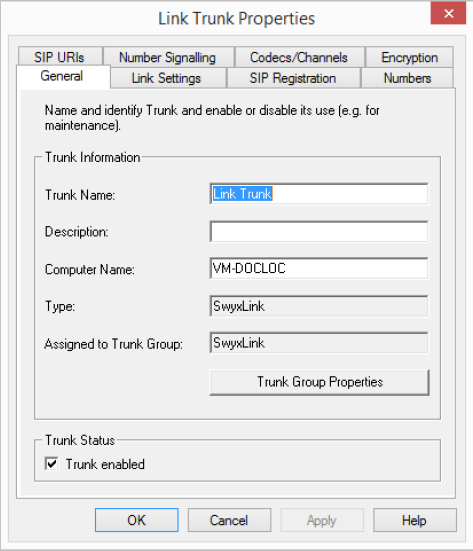
In this tab you can modify the name and description of the trunk.
Trunk information:
In the fields "Trunk Name" and "Description" you will find the descriptive information that is displayed in Administration.
The field "Computer Name" contains the name of the computer in which the service (LinkManager or SwyxGate) is installed.
The "Type" field indicates the type of the trunk, and "Trunk Group" the assigned Trunk Group. Both parameters cannot be retrospectively changed.
Using "Trunk Group Properties..." You will open the Properties of the according Trunk Group. You can edit the Properties of the Trunk Group directly.
Trunk status:
If you deactivate the checkbox "Trunk enabled", this gateway is blocked for further incoming or outgoing calls.
It won't be written in the change log, if a trunk was activated or deactivated.
The "Link Settings" Tab

This tab contains information about managing the SwyxLink trunk.
The "Type" field indicates where the SwyxLink trunk is managed. If it is managed locally, i.e. by the SwyxServer on which the SwyxWare Administration is currently logged in, you will see the names of the computers on which this SwyxLinktrunk is managed remotely under Remote server. Please note that you can only change these settings on the site on which the SwyxLink trunk is locally managed.
Click on "Check Link" to launch an attempt to establish a connection with the remote SwyxServer.
You can use the "Intersite Settings..." button to configure a connection to one or more SwyxServers, in order to make user data and status information visible. This configuration means that status information ("Logged off", "Away", "Do Not Disturb", "Speaking" etc.) can be exchanged between users who are logged in to different SwyxServers. A distinction is made between a connection to a SwyxServer within a user's local organization, and to a SwyxServer outside the local organization.
Intersite Settings
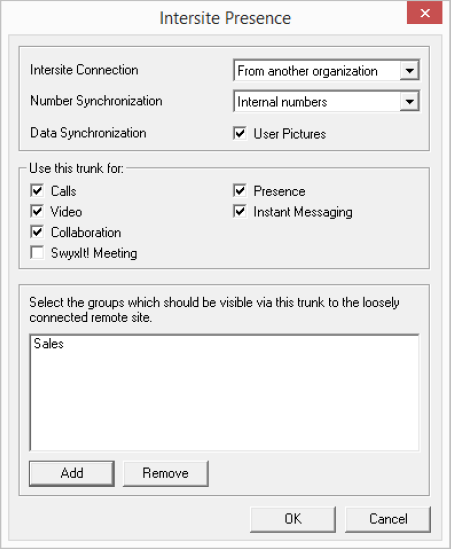
In the field "Intersite Connection" you can specify which type of connection is involved.
Intersite connection
Choose "Without any presence interaction" if you want to disable status signaling across servers for this link.
Choose "In the same organization" if you want to set up a connection to a SwyxServer that is within an organization. With this connection type, all groups and users on all connected sites are visible in the Global Phonebook. The relationships within the user and group properties must be used to specify precisely who should be signaled about the status of a user or group.
Choose "From another organization" if you want to set up a connection to a SwyxServer in a different organization. With this connection type, you can specify individual groups on your SwyxServer to be visible on the SwyxServer of the other organization. The relationships within the user and group properties must be used to specify precisely who should be signaled about the status of the users of a group. The administrator of the other server can take the corresponding action from his end, so that groups on his SwyxServer become visible on your site. Status signaling thus occurs only between users in selected groups. The users in these groups will also be displayed on both sites in the Global Phonebook.
Number synchronization
You use the "Number Synchronization" field to say whether internal, public or both numbers should be synchronized along with the user names between the different servers. A synchronization takes place automatically when changes have been made e.g. to user data, or when a SwyxServer has been restarted.
Data synchronization
In the "Data synchronization" field you can say whether the user pictures stored by the user should likewise be synchronized between the different servers. To save bandwidth, you can deactivate this option.
Use of the trunk
If for some reason you do not want to make calls via this SwyxLink trunk, for instance if you have a flat rate for the PSTN, you can deactivate the "Calls" field. Status signaling via this SwyxLink trunk will then continue, but calls will be routed via the public telephone network (ISDN). If you deactivate this button, the trunk properties for Video, Collaboration and SwyxIt! ClassicMeeting below are deactivated automatically.
If you have deactivated the "Calls" field, you should publish the public numbers. In this case, choose the option "Public numbers" in the call number synchronization field!
If you permit video telephony to users outside the local server, this box should be checked.
If the box is checked, the screen of participants can be transmitted across multiple servers.
The transfer of desktops via SwyxIt! Meeting may only be selected, when Collaboration is activated.
If you deactivate the field "Presence", there is no further status signaling via this SwyxLink trunk. However, the users will still be displayed in the Global Phonebook of the connected SwyxServer.
By activating this check box, it is possible to exchange instant messages with users not logged in to the local server. This feature can only be used, when "status information" is activated.
Please note that enough bandwidth is required in order to use the Video and Collaboration (SwyxIt! Meeting) feature. If not enough bandwidth is available, deactivate these check boxes.
Video and SwyxIt! Meeting connections between different SwyxServer locations require a direct connection of the SwyxIt! Classic clients. Existing firewalls between the locations must be opened for the following ports:
Video (RTP, UDP): 50000-50999 (equivalent to the ports for voice transmission) SwyxIt! Meeting: As of port 49152 (dynamic TCP ports)
Video (RTP, UDP): 50000-50999 (equivalent to the ports for voice transmission) SwyxIt! Meeting: As of port 49152 (dynamic TCP ports)
Group selection
If you have chosen a connection to a SwyxServer of another organization, you can specify individual groups to be visible on the SwyxServer site of the other organization.
Use the "Add" or "Delete" button to select groups, or remove previously added groups.
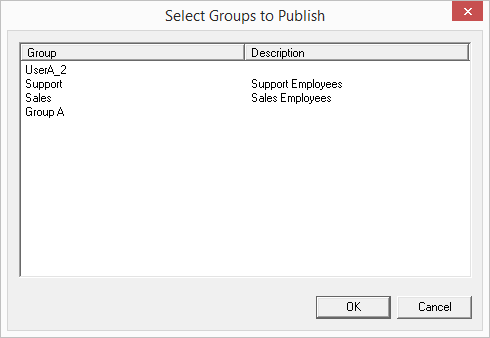
This is how you define an Intersite connection within your organization
If you have deactivated the "Calls" field, you should publish the public numbers. In this case, choose the option "Public numbers" in the number synchronization field!
This is how you define an Intersite connection to another organization
If you have deactivated the "Calls" field, you should publish the public numbers. In this case, choose the option "Public numbers" in the number synchronization field!
This is how you deactivate the display of status information
If the data of the other SwyxServer site should likewise no longer be visible on your SwyxServer, the display of status information must similarly be deactivated on the other side.
The "SIP Registration" Tab
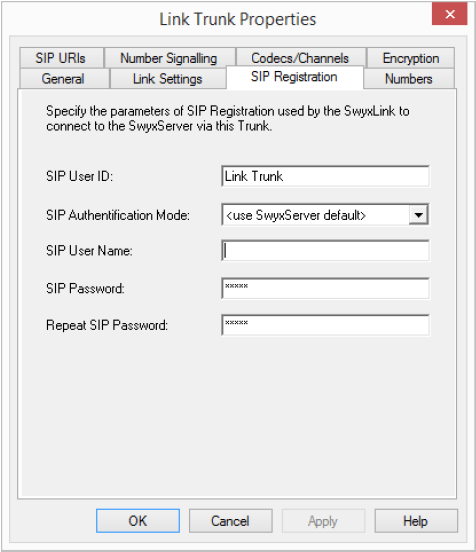
On this tab you can give the SIP access data with which the LinkManager logs on via this trunk to another SwyxServer. For security reasons, you can also specify that the LinkManager must authenticate itself when logging on to the SwyxServer.
SIP User ID:
A unique SIP user ID is needed for logging on to the SwyxServer. This is identical to the name of the trunk as default, but can be changed.
The SIP user ID must be identical on both server sides.
SIP Authentication method
Specify here whether the LinkManager must authenticate itself to the SwyxServer or not.
The following options are available for selection:
If this option is selected, the authentication method selected in the client settings in the server properties is used here. See 7.5.2 The "Client Preferences" Tab.
The LinkManager logs on without authentication.
The LinkManager must always authenticate itself.
SIP user name and password
The SIP user name and SIP password are required for authentication.
The "Numbers" Tab
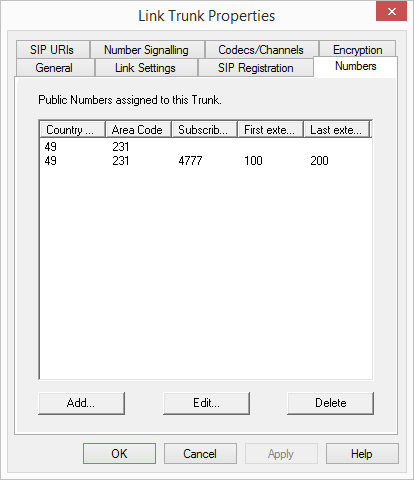
The following settings can be made:
Public numbers of this trunk
You can specify here which public numbers this trunk uses. External calls to these numbers go over this trunk. Calls with a Calling Party Number that is assigned to this trunk are routed over this trunk.
To ensure the unambiguity of the information, you must enter the complete phone number from SwyxWare V.13.20 onwards. In the new "Subscriber number" input field, enter the part of the phone number that follows the area code and precedes the extension (internal phone number).
Country code | Area code | Subscriber number | First extension | Last extension | |
|---|---|---|---|---|---|
e. g. | 49 | 231 | 4777 | 100 | 200 |
This is how you add numbers for this trunk
The existing phone number entries are automatically extended by the new entry field "Subscriber number" when updating to V.13.20. Make sure that the automatic allocation is correct and adjust the corresponding entries manually as required.
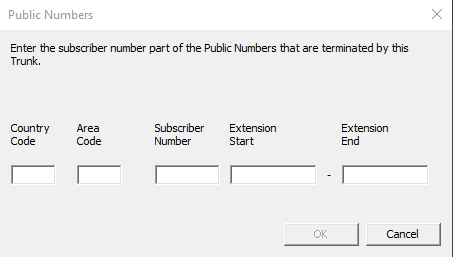
"SIP-URIs"
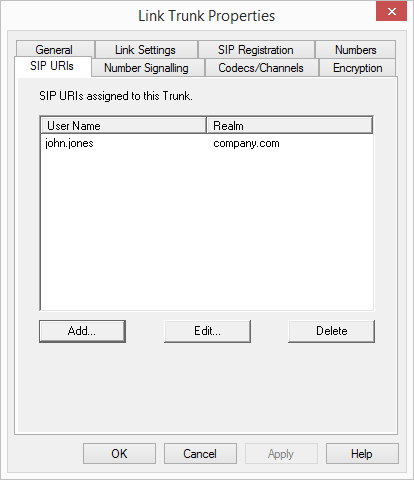
The following settings can be made:
A list of SIP-URIs mapped to this trunk appears here. You can enter further SIP-URIs using "Add". To edit or delete a SIP-URI, highlight it in the list.
See 10.1.3 SIP-URIs.
"Number Signaling"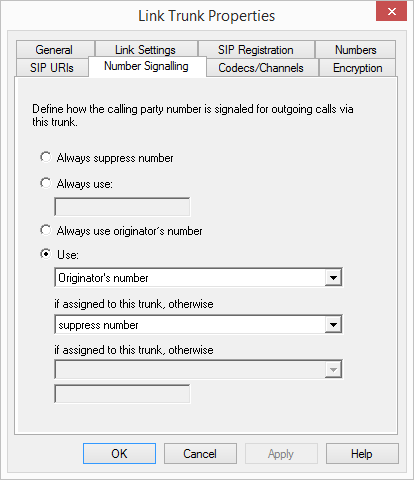

Here you specify whether, and how, the numbers for outgoing calls via this trunk should be signaled.
In this case no number is signaled to the person being called (XXX), regardless of which number was configured for this trunk.
In Germany, the destination numbers 110 and 112 are reserved for emergency calls. The outgoing call number to these destination numbers is always signaled.
You can specify a number or SIP-URI here which will always be signaled to the person being called (e.g. the operator's number), regardless of which number was configured for this trunk.
The number must be entered in canonical number format.
Although the caller number is not configured for this trunk, the caller number is signaled to the person being called.
Example:
Customer A (number 88 333 44) calls employee B (number 55 666 77). Forwarding to his mobile phone is activated, i. e. an incoming call is routed outwards again. If the customer's number (88 333 44) should also be signaled externally, then this can be allowed here, although this number was not defined for this trunk.
You can specify here which number this trunk uses. You can specify the action for numbers that are assigned to this trunk as well as for numbers which have no assignment.
Use: | If assigned to this trunk, otherwise: | If assigned to this trunk, otherwise: | Entry |
|---|---|---|---|
Origination Number | Number of the transferor | ||
Hide number | |||
Don't use this trunk | |||
Use the following number | <Number> | ||
Number of the transferor | Origination Number | Hide number | |
Don't use this trunk | |||
Use the following number | <Number> | ||
Hide number |
The "Codecs/Channels" Tab
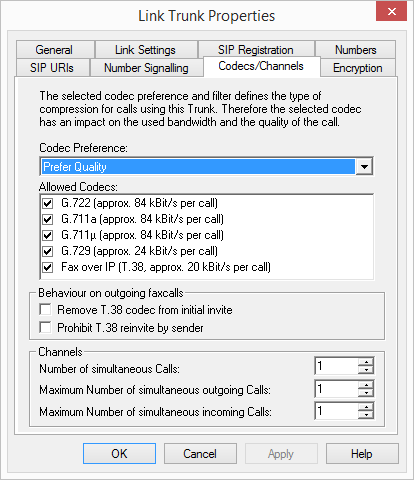
The following settings can be made:
Codecs
Here you can define the type of compression to be used on this connection.
If the Codec priority "Prefer Quality" is selected, the Codecs are provided in the sequence G.722, G.711a, G.711µ, G.729 or Fax over IP. Specify the filter(s) you want:
HD quality
The voice data is slightly compressed. This keeps the packet delay time in the LAN (Local Area Network) to a minimum. A voice connection requires approximately 64kbits/s.
High compression. A voice connection
requires approximately 24kbits/s.
requires approximately 24kbits/s.
In this case, the special fax protocol T.38 is used, which takes the set-up of the IP network into consideration. A fax connection using T.38 requires approximately 20kbits/s.
Click on "Next>".
If there are several voice codecs selected, SwyxServer will filter voice data according to the current settings. The communicating sides will have to decide which voice codec to use.
It won't be written in the change log, if a Codec was activated or deactivated. See also 7.7 Change log.
Action on fax receipt
When a fax connection is set up, the T.38 protocol is negotiated between the two devices involved. Certain variants of this negotiation may not be supported by some IP adapters. Use the following filter options to establish compatibility with such devices.
Some IP adapters cannot correctly interpret an initial connection request which includes T.38 as well as voice Codecs.
If this option is set, SwyxServer removes T.38 from the initial connection request. The fax devices first set up a voice connection and then switch to the fax protocol T.38 because of the fax tone (CED tone, 2100Hz).
Prohibit T.38 reinvite by sender
The receiving fax device switches to T.38 after detecting the fax tone (CED tone, 2100Hz). Alternatively, the switch to T.38 can be carried out by the sending fax device.
Some IP adapters don't support switching by the sender.
If this option is set, SwyxServer suppresses a switch to T.38 by the sender.
If the receiving side involves a combined phone/fax device (fax switch), a fax data transmission is impossible when the option "Prohibit T.38 reinvite by sender" is activated.
The filter options can only be set when the Codec "Fax over IP (T.38...)" is activated.
Channels
Specify how many channels (connections) should be simultaneously routed over this trunk. You can also determine how many outgoing and/or ingoing connections are established at most.
The maximum number of channels could be calculated from the available bandwidth and the Codec settings.
Please note that all settings made for this SwyxServer at location A for the SwyxLink trunk to location B must correspond with the settings made on the other SwyxServer at location B for the SwyxLink trunk to location A.
If channels were added or removed, you will find these changes in the change log. See also 7.7 Change log.
The "Encryption" tab

You can see here how and whether voice data going via this trunk should be encrypted. The settings were selected within the server properties, and apply equally to the SwyxLink trunk. See also 7.5.18 The "Security" tab.
For a SwyxLink trunk, it is advisable to configure both server sides identically in relation to encryption.
Whether a call is established via the SwyxLink trunk, and whether it is correspondingly encrypted from end point to end point (e.g. from SwyxIt! Classic to SwyxIt! Classic), depends on the encryption settings within the user properties on both servers. See also 21 Encryption.
Key (PreSharedKey)
To ensure secure communication by SRTP between two SwyxServers, a common key (PreSharedKey) must be defined between them.
For all components which use the SwyxWare database (e.g. SwyxIt! Classic, PhoneMgr, ConferenceMgr, LinkMgr, Gateway), this key is automatically generated by SwyxServer and distributed to the relevant component, once again encrypted.
It is different for a SwyxLink trunk. In this case the key must be entered manually. Furthermore, the key entered here must likewise be entered in the SwyxLink trunk properties of the linked server.
A key length of less than 10 characters is not advisable. Longer keys offer greater security, and keys can be up to 128 characters long. In order to make brute-force or dictionary attacks more difficult, the key should consist of a combination of letters, numbers and special characters.
See also 21.1 Encryption within SwyxWare.
This is how you specify a key for the encryption of a SwyxLink trunk